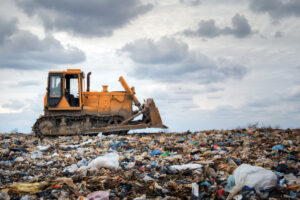The EPA has approved the use of the SnifferDRONE, an environmental technology product produced by Sniffer Robotics LLC, as an alternative for monitoring methane emissions from landfills.

Certain landfills are required to perform surface emissions monitoring (SEM) procedures on a quarterly basis to demonstrate compliance with the 500 parts per million (ppm) above background concentration operational standard at the surface of the landfill. The SEM test procedures involve using a detector to (1) traverse the entire perimeter of the gas collection area; (2) traverse a pattern on the landfill collection area at a maximum of 30-meter intervals; and (3) sample areas of the landfill where visual observations indicate elevated concentrations could be present, such as distressed vegetation or cracks or seeps in the landfill cover.
Rule history
Under the Resource Conservation and Recovery Act (RCRA), many municipal solid waste landfills (MSWLFs) are required to conduct gas monitoring for methane. Some landfills are exempt from this requirement, depending on the date of construction. The EPA regulations on this requirement also provide flexibility in how states and tribal authorities implement these regulations.
In 2016, the EPA announced final updates to its New Source Performance Standards (NSPS) to reduce emissions of methane-rich landfill gas from new, modified, and reconstructed MSWLFs. In a separate action, the Agency also issued guidelines for reducing emissions from existing MSWLFs.
In February 2020, the EPA amended the NSPS and emissions guidelines (EGs) to allow landfills subject to the National Emissions Standards for Hazardous Air Pollutants (NESHAP) to opt in to certain compliance provisions. The following month, the Agency issued a notice of failure to submit state plans, identifying 42 states and territories that failed to submit for review and approval state plans to implement the 2016 EG for MSWLFs. This finding does not establish sanctions for states that have failed to submit state plans or set deadlines for imposing sanctions.
Alternative methane emissions monitoring
For now, the SnifferDRONE is the only approved drone-based landfill methane emissions monitoring device.
“Entities other than Sniffer Robotics, LLC must submit data comparing OTM-51 and the test method specified by the regulation(s) to the Method Technology Group for review before this alternative test method may be used in lieu of SEM test procedures specified by the applicable regulations,” states the EPA approval letter.
“[T]he SnifferDRONE's ‘hyper-local’ solution is unique in its ability to collect air samples directly at the ground surface, measure the methane concentration within the collected air samples in parts per million (ppm) and correlate the measurements to discrete latitude/longitude coordinates during flight,” the Sniffer Robotics press release says. “This data is then transformed to provide specific leak locations consistent with [EPA] regulations as actionable information. The data can also be transformed to estimate fugitive gas emissions and presented on a temporal basis to understand gas migration on the site in conjunction with operational changes.”
To date, the SnifferDRONE system is in use in 28 states at more than 150 landfill sites and has now identified more than 16,500 leak sources.
For more information on EPA-approved alternative testing methods, see the EPA Broadly Applicable Approved Alternative Test Methods website.